
Bob Sorensen of Hyperion Research
In the face of tremendous complexities and uncertain progress, quantum computing continues to draw significant investments and R&D efforts from countries and companies around the world. A key reason: an “increasing concern about the trajectory of classical HPC,” according to Bob Sorensen, SVP of research at HPC industry analyst firm Hyperion Research, who delivered a “whirlwind tour” of quantum last week at a HPC User Forum hosted by Hyperion in Washington.
“We’re starting to see ‘end of’ stories,” such as the winding down of Moore’s Law and Dennard Scaling, he said. There’s also the escalating cost of building supercomputers with their associated, astronomical power demands. It’s a reason, Sorensen said, that quantum computing development work is happening “at such an opportune time in the HPC world.”
That said, Sorensen expressed what has become a consensus view that quantum’s role will be to take on specialized workloads for which it is suited, it will augment classical HPC, not replace it.
“We don’t see quantum as this island of alternate compute capability that can in some way challenge classical HPC,” he said. “We see quantum as yet another tool in the toolbox for solving complicated problems. In the advanced computing world, it’s perhaps another evolutionary step. Where we had things like multi-processors, GPUs, MPI, if you consider all of that progress, then quantum is the next step in this evolution.”
Here’s a run down of insights offered by Sorensen supported by recent surveys conducted by Hyperion:
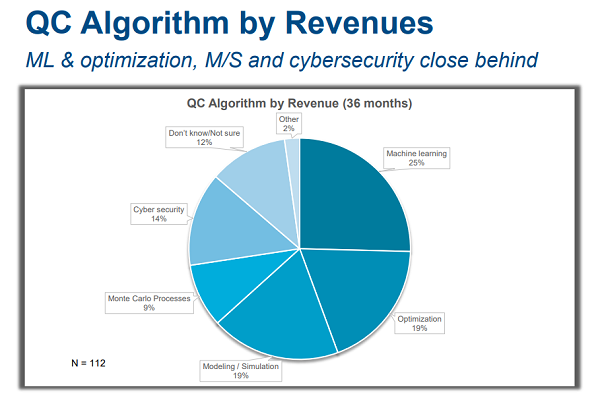
source of all charts: Hyperion Research
A Shift from Supremacy to Advantage – The initial excitement about quantum centered on the notion of “quantum supremacy,” which Sorensen defined as “using a programmable quantum device to solve a problem that no classical computer can solve in any feasible amount of time.” This would include factoring a large number into its two prime integers.
But now the quantum community has downshifted somewhat and has targeted “quantum advantage,” or quantum competitive advantage, which Sorensen characterized by the question: “What can I do better (with quantum) than a classical system. It doesn’t have to be an intractable problem, but what if I give you 50, or 20, percent performance gains? Or what if it just gives me a simple competitive advantage, I can do something that my competitor can’t because I’m quantum capable and he’s not. It’s a much more realistic view of how the world can be.”
This includes optimization workloads already being run using hybrid quantum/classical HPC techniques. Sorensen cited Airbus, which he said is currently one of the largest end users most interested in quantum.
“They’re everywhere, they have programs, they’re looking for any possible way to do things, from wing design all the way down to ‘the knapsack problem’ – the best way to load luggage in the belly of an Airbus jet that’s at a terminal and you want to turn it around in 15 minutes. The quantum computer gives you an optimal algorithm to pack that thing. Optimal space, minimum time, load up and load out.”
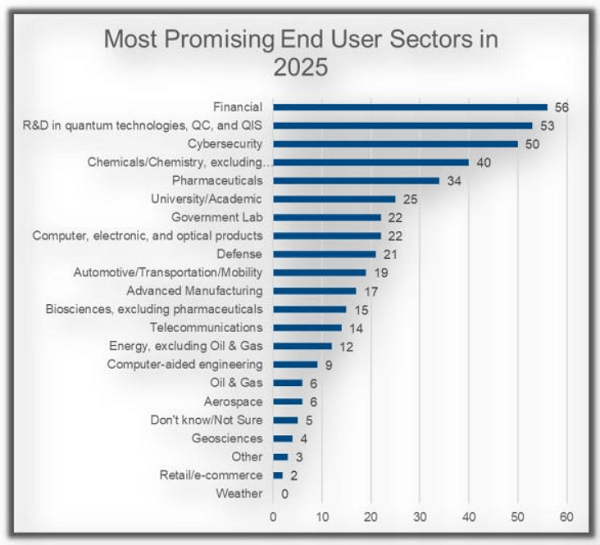 Top 3 Quantum Sectors: Based on Hyperion surveys, Sorensen said the top three end user sectors – sectors that see the most promise from quantum by 2025 – are financial services; R&D related to quantum technologies, quantum computing and quantum information science; and cybersecurity.
Top 3 Quantum Sectors: Based on Hyperion surveys, Sorensen said the top three end user sectors – sectors that see the most promise from quantum by 2025 – are financial services; R&D related to quantum technologies, quantum computing and quantum information science; and cybersecurity.
The latter is generating strong interest from the private and public sectors, with the emergence of a high-stakes U.S. vs. China quantum competition that is, one government official told us, “a race to see who can shut the other down first.” For now, that race is in preparation for when quantum is more fully developed.
“This idea of post quantum encryption, the phrase people are using is “save now decrypt later,” Sorensen said, “which means that everything that’s going over the internet right now, or certainly within any kind of available government channels, is being sucked up by somebody. The data is encoded, but five or 10 or 15 years from now, they will read it with a quantum system.”
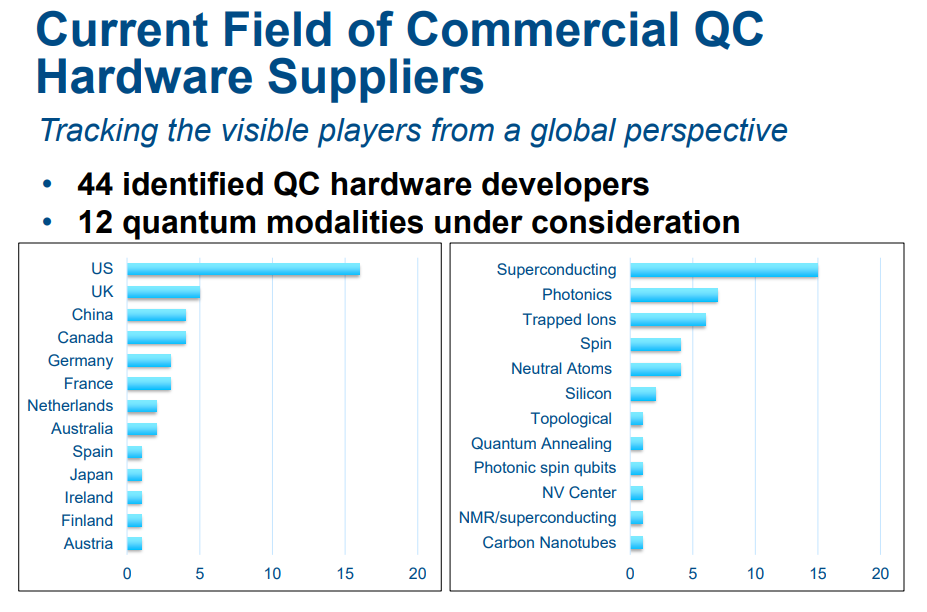 Quantum Is Global: Despite myriad quantum challenges, that hasn’t stopped government-funded or private sector R&D – countries and companies all over the world are pouring money into quantum R&D. And while the U.S. is leading the way, Europe, China and India have major efforts underway.
Quantum Is Global: Despite myriad quantum challenges, that hasn’t stopped government-funded or private sector R&D – countries and companies all over the world are pouring money into quantum R&D. And while the U.S. is leading the way, Europe, China and India have major efforts underway.
On the private sector side, Sorensen said Hyperion has identified 44 quantum computing hardware developers.
“Sure, the US has a lot of companies,” he said, “but there’s an awful lot of organizations around the world looking at quantum and they’re building different types of quantum systems that are fundamentally different…They use different materials, they use entirely different mechanisms to establish the quantum phenomenon needed to do computation.”
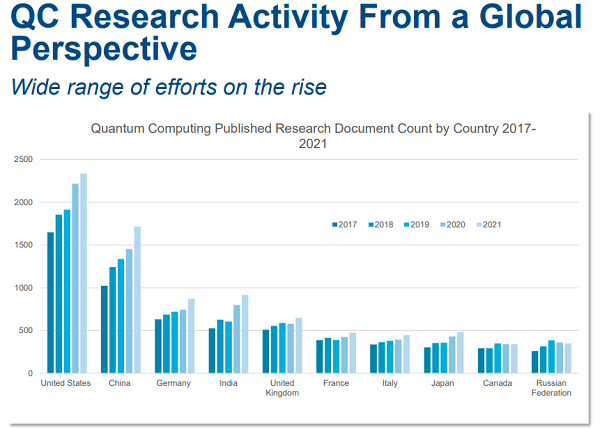
At the national level, published research documents indicate relative levels of R&D, with increasing activity happening globally.
“This means there’s a broad range of diversity…,” Sorensen said. “If you’re in a government and haven’t earmarked at least a $1 billion or $2 billion for quantum computing development, you’re not even worth mentioning anymore. Everybody’s got a program, every government has recognized this as a national agenda item.”
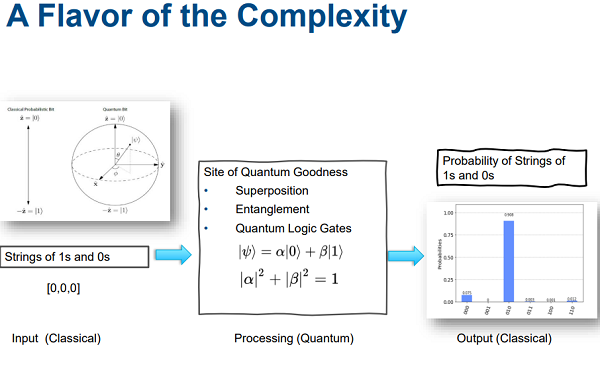 Quantum Complexity: Quantum presents endless complexities in part because quantum science is the study of existence at the atomic and subatomic level where things happen differently — very differently — from Newtonian life as we know it. Another source of complexity: quantum computing does not utilize the bits and bytes of traditional, von Neumann computers. The basic unit of quantum information is a qubit, represented by the “Bloch sphere” in the above slide. Whereas a bit is either a one or a zero, a qubit can take on a value anywhere on the outside of the sphere.
Quantum Complexity: Quantum presents endless complexities in part because quantum science is the study of existence at the atomic and subatomic level where things happen differently — very differently — from Newtonian life as we know it. Another source of complexity: quantum computing does not utilize the bits and bytes of traditional, von Neumann computers. The basic unit of quantum information is a qubit, represented by the “Bloch sphere” in the above slide. Whereas a bit is either a one or a zero, a qubit can take on a value anywhere on the outside of the sphere.
“So there’s lots of variations of where it (the value) can be (on the sphere),” Sorensen said, “you can be all the way up, you can be all the way down, you can be anywhere on the sphere in terms of phase and other angles. And that gives you the power of quantum, the ability to encapsulate data in a much more rich environment.”
The bit/qubit difference means exchange of information between, say, an HPC system and the quantum environment is a major challenge.
“The issue here is that when you want to put an input to a quantum system, you have to start with bits, that’s how the world works, we live in a classical environment, we don’t live in the quantum realm. Sorensen said. “That limits your ability to do anything in the quantum space. Now you get into the quantum system, and you get all sorts of great quantum goodness, you can do all sorts of incredibly complex calculations, huge interactions, that’s where you get quantum advantage and … explore all of the potential factors almost simultaneously. It’s where you can do some interesting modeling of molecular interactions, very complex interactions between molecules.”
But that leads to the next problem: getting results out of the quantum system.
“So now we’re coming out of quantum goodness, we now have to collapse back down to the classical world,” Sorensen said. “The thing that’s perhaps most pernicious, is we don’t get ones and zeros out (of a quantum system), we get probabilities of ones and zeros, we get a histogram of answers. Which is why when you run a quantum calculation you ask how many shots (quantum runs) you have to do. If I want a good histogram, something that is relatively realistic, I may have to do 1000, or maybe 5000, shots to get a histogram that looks a (good) answer.”
Many more challenges exist across the quantum landscape. On the business side, Sorensen said this includes the relatively short ROI timeframe of the venture capital industry over against the lengthy R&D roadmap that lies ahead for quantum. Another is a shortage of quantum talent. Yet the development works goes on, cloud-based quantum platforms from IBM, Microsoft and Amazon, to name three, are readily available and offer an inexpensive point of entry for organizations and individuals seeking to sample quantum.
“Quantum is here,” Sorensen said. “It’s got a way to go but it simply can’t be ignored as a as a force to be reckoned with in the next five minutes all the way out in the next couple of decades.”



